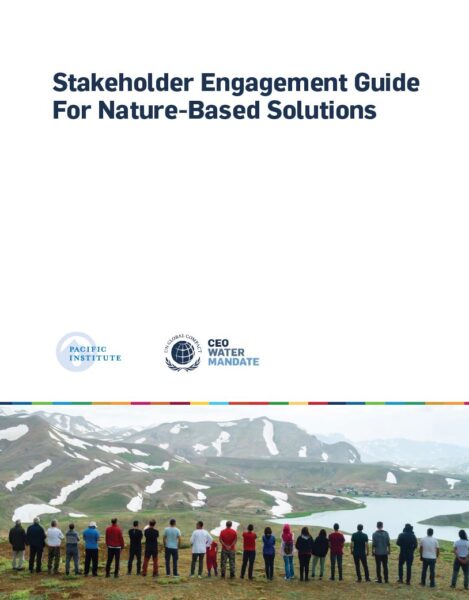In California water news this weekend …
As California droughts intensify, ecosystems and rural communities will bear the brunt
“Drought, human-caused climate change, invasive species and a “legacy” of environmental issues are permanently altering California’s landscape and placing some communities and ecosystems at increasing risk, a panel of experts told water officials recently. Invasive species and decades of disruptions from massive land and water developments are partly responsible for a continuous decline in native California species, experts told the California Water Commission on Nov. 16. Also, rural communities, many of whom are lower income and rely on privately owned wells, are disproportionately contending with water contamination and scarcity amid recurring cycles of drought, experts said. … ” Read more from the LA Times here: As California droughts intensify, ecosystems and rural communities will bear the brunt | Read via AOL News
Long-serving, controversial manager of Westlands Water District resigns
“Longtime Westlands Water District General Manager Tom Birmingham announced Nov. 23 that he will retire as of Dec. 31. “I am retiring with extreme pride in the things Westlands had accomplished over the last two decades,” he wrote in an email announcement. Birmingham had faced the likelihood that a newly-elected majority on the Westlands board was poised to replace him after the new members were seated on Dec. 2. Instead, he will step down from the district he has served for more than 36 years, according to a Westlands announcement. It’s anticipated that Birmingham will take with him a healthy severance of at least $664,000. … ” Read more from SJV Water here: Long-serving, controversial manager of Westlands Water District resigns
EXPLORE MORE COVERAGE:
- Westlands boss Thomas Birmingham retiring after ‘change coalition’ elected to board, from the Sacramento Bee
- With rise of ‘change coalition,’ Birmingham steps down at Westlands, from The Business Journal
- Tom Birmingham, general manager of Westlands Water District, will retire at end of 2022, from Dan Bacher at the Daily Kos
- Amid shake-up, Westlands GM Birmingham to retire, from the San Joaquin Valley Sun
Water recycling technologies developed for space are helping a parched American west
“Whether you live in the rapidly drying American West or are aboard the International Space Station for a six-month stint, having enough water to live on is a constant concern. As climate change continues to play havoc on the West’s aquifers, and as humanity pushes further into the solar system, the potable supply challenges we face today will only grow. In their efforts to ensure humanity has enough to drink, some of NASA’s cutting-edge in-orbit water recycling research is coming back down to Earth. … ” Read more from Engadget here: Water recycling technologies developed for space are helping a parched American west
The EPA, CWA and invasive organisms

“Last month, a letter signed by 160 organizations was sent to President Joseph Biden Jr. requesting that he take action to direct the EPA to implement discharge standards for ships’ ballast water that comply with the Clean Water Act (CWA). EPA administrator Michael Regan also received a similar request from 34 members of Congress. “Ballast water discharges are the leading source of invasive species in U.S. waters, posing public health and environmental risks, as well as significant economic cost to industries such as water and power utilities, commercial and recreational fisheries, agriculture, and tourism,” states the letter from the Congressional members. “EPA’s compliance with the CWA here is overdue.” … ” Continue reading at the EHS Advisor here: The EPA, CWA and invasive organisms
Cheap, sensor-based agriculture could slash water use by up to 70%
“For all the progress our society has made, we’re still nothing without agriculture. But agriculture has also changed a lot: increasingly, an array of sensors equipped with relatively simple hardware and smart software are being used to make agriculture more efficient and sustainable — and given that agriculture is one of the main contributors to habitat destruction and climate change, this would definitely come in handy. … unexpected help may come from the internet. The internet you’re using to read this now can be used for a number of different things, including connecting sensors and other objects. The so-called Internet of Things (IoT) means that you no longer need to go out into a field to inspect it and take samples for analysis — you can leave the sensors in place and they communicate using wireless protocols. These technologies have advanced tremendously in recent years, becoming not only more precise and robust, but also cheaper — a key demand for agriculture. … ” Read more from ZME Science here: Cheap, sensor-based agriculture could slash water use by up to 70%
Climate change and drought could drive more indoor farming
“The sea of greenhouses sat in manicured rows in Half Moon Bay’s Rocket Farms, as if someone took a model and reproduced dozens of exact versions of the same glass building. But Rocket Farms president Nick Bavaro walked past the rows of buildings with their faded white paint, pointing out the buildings represented multiple eras of greenhouse technology — from the inefficient 70-year-old wood buildings to ones filled with state-of-the-art technology where legions of high-tech robotics were carrying out everything from planting to packing. As California agriculture continues to suffer in the grips of the state’s historic drought, Bavaro explained how indoor farming may be hitting its heyday, with its ability to reuse irrigation water, and grow food all year round in climate-controlled buildings. “What this enables us to do, versus traditional outdoor growing,” Bavaro said, “is to grow our product on a year-round basis with consistency.” … ” Read more from NBC Bay Area here: Climate change and drought could drive more indoor farming
Stakeholder engagement guide for Nature-Based Solutions
 “This guide takes a pragmatic approach to stakeholder engagement by presenting general principles and best practices that should be considered throughout all stages of an NBS project, as well as outlining specific steps for incorporating stakeholder engagement throughout NBS project stages. The identified principles and best practices include engaging a diverse range of stakeholders; building long-term relationships and trust; communicating with empathy; prioritizing transparency and accountability; co-creating rather than imposing; recognizing mutual benefits; removing barriers to engagement; formalizing relationships; ensuring adequate financial support; and appointing well-trained, knowledgeable facilitators.” View/download guide from the Pacific Institute here: Stakeholder engagement guide for Nature-Based Solutions
“This guide takes a pragmatic approach to stakeholder engagement by presenting general principles and best practices that should be considered throughout all stages of an NBS project, as well as outlining specific steps for incorporating stakeholder engagement throughout NBS project stages. The identified principles and best practices include engaging a diverse range of stakeholders; building long-term relationships and trust; communicating with empathy; prioritizing transparency and accountability; co-creating rather than imposing; recognizing mutual benefits; removing barriers to engagement; formalizing relationships; ensuring adequate financial support; and appointing well-trained, knowledgeable facilitators.” View/download guide from the Pacific Institute here: Stakeholder engagement guide for Nature-Based Solutions
Climate change is increasing the frequency and temperature of extreme heat waves
“As California awakens to the worsening risk of extreme climate events, researchers are shedding new light on last year’s anomalous and extreme Pacific Northwest heat wave. One study published this week said such heat waves could become 20 times more likely to occur if current carbon emissions continue unabated. Another said they may also be nearly 10 degrees hotter. The nine-day event in late June and early July 2021 seared parts of Northern California, Oregon, Washington and British Columbia, where Canada saw its highest temperature on record, 121.3 degrees. The heat wave claimed hundreds of lives, sparked several devastating wildfires and killed an estimated 1 billion sea creatures. Such an event would have been “virtually impossible” in the 1950s, but atmospheric warming has already increased its probability to about a 0.5% chance per year, according to one study out of Columbia University, published Thursday in the journal Nature Climate Change. … ” Read more from the LA Times here: Climate change is increasing the frequency and temperature of extreme heat waves
They’re knee deep in the climate trenches. Here’s what gives them hope
Sammy Roth writes, “You’re probably just as tired of reading dire climate change news as I am of writing it. So this week — when we’re all doing our best to practice gratitude and remind ourselves of the good things in life, and eat some delicious food — let’s try something different: Let’s talk hope. Last year on Thanksgiving, I asked my L.A. Times colleagues who write about environmental calamity what gives them hope. This year, I reached out to nine people who work on environmental issues or who otherwise deal with the climate crisis in their professional lives. I asked them what makes them optimistic, what keeps them going. Here’s what they had to say. ... ” Read more from the LA Times here: They’re knee deep in the climate trenches. Here’s what gives them hope
In commentary this weekend …
Editorial: Water and power are essential. Disconnecting services when people can’t afford to pay is cruel
The LA Times editorial board writes, “The Los Angeles Department of Water and Power has made a radical but logical decision: The utility will no longer shut off service when low-income residents and seniors can’t pay their bills. Instead, those customers will be put on payment plans that can stretch over several years, offered incentives to help lower their water and power use and, if they qualify, be enrolled in federal programs to help households in poverty pay for utilities. It’s an important change, recognizing that water and power are essential services. It’s cruel to cut people off if they fall behind on their bills due to financial hardship. ... ” Read more from the LA Times here: Editorial: Water and power are essential. Disconnecting services when people can’t afford to pay is cruel
In people news this weekend …
Promotions, passings, profiles – submit people news items to maven@mavensnotebook.com.
San Diegan Lois Fong-Sakai elected MWD Board Secretary
 “San Diego County Water Authority board member Lois Fong-Sakai has been elected secretary of the Board of Directors of the Metropolitan Water District of Southern California. Fong-Sakai, who represents the City of San Diego on the Water Authority board, is a registered civil engineer in California and Nevada. She becomes the first Asian-American to service on the board of the Los Angeles-based water wholesaler serving nearly 19 million people in six counties. “It’s a great honor to serve not only San Diego County, but all of Southern California,” said Fong-Sakai. “Extreme drought conditions create significant challenges that will be best addressed through collaboration and cooperation across the region.” ... ” Read more from the Water News Network here: San Diegan Lois Fong-Sakai Elected MWD Board Secretary
“San Diego County Water Authority board member Lois Fong-Sakai has been elected secretary of the Board of Directors of the Metropolitan Water District of Southern California. Fong-Sakai, who represents the City of San Diego on the Water Authority board, is a registered civil engineer in California and Nevada. She becomes the first Asian-American to service on the board of the Los Angeles-based water wholesaler serving nearly 19 million people in six counties. “It’s a great honor to serve not only San Diego County, but all of Southern California,” said Fong-Sakai. “Extreme drought conditions create significant challenges that will be best addressed through collaboration and cooperation across the region.” ... ” Read more from the Water News Network here: San Diegan Lois Fong-Sakai Elected MWD Board Secretary
Elsinore Valley Municipal Water District mourns the loss of Board Director Phil Williams
 “Elsinore Valley Municipal Water District board of directors and staff were saddened by the death of Board Director Phil Williams. Director Phil Williams served on EVMWD’s board of director since 2001, representing EVMWD’s Division 4, which includes areas of Corona and western Lake Elsinore, as well as the unincorporated communities of Horsethief Canyon and Alberhill. “We have lost an admired and respected member of the EVMWD family” said Elsinore Valley Municipal Water District General Manager Greg Thomas. “His insights and contributions to the District and the community will be part of his legacy for years to come.” … ” Read more from the Elsinore Valley MWD here: Elsinore Valley Municipal Water District mourns the loss of Board Director Phil Williams
“Elsinore Valley Municipal Water District board of directors and staff were saddened by the death of Board Director Phil Williams. Director Phil Williams served on EVMWD’s board of director since 2001, representing EVMWD’s Division 4, which includes areas of Corona and western Lake Elsinore, as well as the unincorporated communities of Horsethief Canyon and Alberhill. “We have lost an admired and respected member of the EVMWD family” said Elsinore Valley Municipal Water District General Manager Greg Thomas. “His insights and contributions to the District and the community will be part of his legacy for years to come.” … ” Read more from the Elsinore Valley MWD here: Elsinore Valley Municipal Water District mourns the loss of Board Director Phil Williams
Podcasts …
THE DROP PODCAST (Eastern Municipal Water District): Water 101
In this pilot episode, Eastern Municipal Water District (EMWD)’s General Manager, Joe Mouawad discusses the basics of EMWD’s services and why talking about water and keeping it front of mind is so important.
THE DROP PODCAST (Eastern Municipal Water District): State of Affairs
A look at EMWD’s legislative program and the top initiatives we are currently working on as well as what’s to come for water at the state and federal levels.
WATER IS A MANY SPLENDOR’ED THING PODCAST: Dundee, Scotland
 Have you asked yourself why certain cities and towns were built where we see them today and to what degree did water enter that situation? Water is a Many Splendor’ed Thing brings you another water relationship that has a personally significant impact to your life. Produced by Steven Baker, Bringing People Together to Solve Water Problems, water@operationunite.co 530-205-6388
Have you asked yourself why certain cities and towns were built where we see them today and to what degree did water enter that situation? Water is a Many Splendor’ed Thing brings you another water relationship that has a personally significant impact to your life. Produced by Steven Baker, Bringing People Together to Solve Water Problems, water@operationunite.co 530-205-6388
WHAT ABOUT WATER PODCAST WITH JAY FAMIGLIETTI: Submerged
In regional water news and commentary this weekend …
NORTH COAST
Tribal traditions: The burning battle (Part 2)
“Wildfire outbreaks have been synonymous with drought in California, in Part 2 of “Tribal Traditions: The Burning Battle” climate adaptation series, Carley Gomez shows how it’s not just homes being lost, but entire ways of life. The Karuk Tribe’s aboriginal land makes up about 1 million acres. As wildfires roar through the Siskiyou and Klamath National Forests, tribal members are witnessing different ways of life from what they learned through their ancestors. Tribal member Kenneth Brink also known as “Binx,” knows this all too well. “People along the river would start burning their little piles, because we knew fire was coming. We knew that we had to manage our land; we had to do fuels reduction” said Brink. … ” Read more from Channel 10 here: Tribal traditions: The burning battle (Part 2)
MOUNTAIN COUNTIES
Caldor Fire: Congress demands answers
“Members of Congress are inquiring about a failed U.S Forest Service plan that could have saved Grizzly Flat from being destroyed by the Caldor Fire. In a Nov. 18 letter to Forest Service Chief Randy Moore, lawmakers demand answers on shortcomings of the Forest Service’s Trestle Forest Health Projet, meant to remove 15,000 acres of fire fuels to protect the town from potential wildfire. The Caldor Fire started in the Eldorado National Forest near Omo Ranch and razed hundreds of homes in Grizzly Flat. … ” Read more from the Tahoe Daily Tribune here: Caldor Fire: Congress demands answers
November snow storms provide earliest South Tahoe ski resort opening in years
“The early snowstorms and cold temperatures this month have the season in high gear with the earliest opening in more than decade at South Tahoe ski resorts. The timely weather portends a triumphant winter for South Lake Tahoe especially with active weather patterns in the forecast for early next week. It all sets the stage with what’s new and can be expected for winter enthusiasts during the 2022-23 season … ” Read more from South Tahoe Now here: November snow storms provide earliest South Tahoe ski resort opening in years
Placer County to provide update on Lower Secline Water Quality Project
“Placer County continues to make progress on the Kings Beach Water Quality Plan and will host a public meeting in December to provide residents with an update. The Placer County Department of Public Works is planning to move forward with the Lower Secline Water Quality Project, which will pave the roadways and formalize parking at Secline Street and Brockway Avenue in Kings Beach. The project is intended to prevent fine sediment from the unpaved roadways from entering Lake Tahoe through stormwater runoff, thereby impacting water clarity. … ” Read more from Roseville Today here: Placer County to provide update on Lower Secline Water Quality Project
EASTERN SIERRA
Ridgecrest: Water District discusses two tier system for water rates
“The Indian Wells Valley Water District is considering moving away from a four tiered water system and to a two tiered system, according to a presentation and discussion at their November 14 board meeting. If adopted, the board would use this simplified two tier system to define low water users and high water users, with high water users picking up the bill for Groundwater Sustainability Agency replenishment costs. The presentation was given remotely by Mark Hildebrand at Hildebrand Consulting, a consulting firm which the Water District hired to support them with the rate study project. ... ” Read more from the Ridgecrest Independent here: Ridgecrest: Water District discusses two tier system for water rates
SOUTHERN CALIFORNIA
Saving water in L.A., one leaky toilet at a time
“In water-scarce regions like California, every last drop counts. Yet millions of gallons of water are lost every year to a common, yet easily preventable, cause of water waste: leaky toilets. That’s why we recently co-funded a pilot project to install water-saving technology in three multi-family buildings in Los Angeles. The tech takes aim at common leaks, like toilets that keep running water when not in use, which can add up over time. The pilot is on track to save 6.4 million gallons of water a year in the L.A. watershed where we operate, supporting our commitment to replenish 120% of the water we consume, on average, across our offices and data centers by 2030. The pilot came together with partners from the California Water Action Collaborative (CWAC), a water stewardship network of over 25 organizations — including private companies like Google alongside environmental NGOs and nonprofits — that are committed to improving water security across the state. … ” Read more from the Google blog here: Saving water in L.A., one leaky toilet at a time
One year Later: A look at Santa Margarita Water District’s acquisition of San Juan Capistrano’s water utilities
“The Santa Margarita Water District officially took over San Juan Capistrano’s water services on November 15, 2021. A year after the city acquiesced the utility, SMWD General Manager Dan Ferons said the annexation has gone well. The Santa Margarita Water District did a lot of preliminary work and investigation before being handed the proverbial keys, he said. SMWD has invested $5.6 million in water improvements so far, including increased capacity for the groundwater treatment plant, upgrading pumping stations, and rebuilding their data acquisition system so operations can be done remotely. … ” Read more from the Capitrano Dispatch here: One Year Later: A Look at Santa Margarita Water District’s Acquisition of San Juan Capistrano’s Water Utilities
SAN DIEGO
Commentary: Sweetwater drains Loveland reservoir to dead pool level to save its ratepayers money– at the expense of rural residents, wildlife, and fire protection
Miriam Raftery writes, “Without any regard to impacts on wildlife, fire danger, rural residents or recreational users at Loveland Reservoir near Alpine in San Diego’s East County, the Sweetwater Water Authority (SWA) on November 16 began draining down the lake with an intent to reduce it to “dead pool” level – less than one-half of one percent of the reservoir’s capacity, once draining is completed over the next couple of weeks or so. The water is being piped to Sweetwater Reservoir in Otay Mesa. From there, it will be used to provide drinking water and other water needs to residents in the South Bay communities of Chula Vista, National City and Bonita. But critics say the action is destroying habitat for wildlife, perhaps forever, also eliminating fishing at the area’s only reservoir with free fishing access, and threatening firefighters’ ability to combat fast-moving wildfires. … ” Continue reading at the East County Tribune here: Commentary: Sweetwater drains Loveland reservoir to dead pool level to save its ratepayers money– at the expense of rural residents, wildlife, and fire protection
National water and climate update …
The Natural Resources Conservation Service produces this weekly report using data and products from the National Water and Climate Center and other agencies. The report focuses on seasonal snowpack, precipitation, temperature, and drought conditions in the U.S.
dmrpt-20221123Also on Maven’s Notebook this weekend …
NOTICE: San Joaquin River Restoration Program increases Restoration Flows to benefit salmon during winter
Return to top



